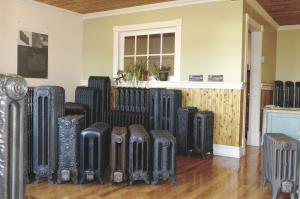2013 - Volume #37, Issue #1, Page #02
[ Sample Stories From This Issue | List of All Stories In This Issue | Print this story
| Read this issue]
Cast Iron Radiators Reborn As Stand-Alone Space Heaters
 |
“Cast iron radiators are extremely efficient, but coats of paint can reduce efficiency by 10 percent,” says Lemieux. “Cleaned up, they’re 18 percent more efficient than electric convection heaters and offer a more comfortable and healthy heat than forced air or convection. With our heating element, they’re also more efficient than hot water or steam systems.”
Many cast iron radiators are prized for their decorative look. Lemieux notes that different parts of Canada and the U.S. feature different designs. He adds that radiators made in North America are much higher quality than those made elsewhere.
“The foundry work is amazing in detail,” says Lemieux. “I have a Verona from American Radiator, probably cast in the Detroit area, and you can almost pick out the grains of sand it was cast in. It’s a work of art.”
Lemieux has developed his own system for removing old paint and has developed a proprietary heating core. To preserve the detailed look, his crew uses water pressure at 12,500 psi with low water flow.
“The old paint is often lead contaminated, so the less water used, the better,” says Lemieux. “We run the wastewater through a centrifuge to remove the lead and then reuse the water.”
The heating element is made to order by a Montreal manufacturer. Lemieux keeps a large inventory in order to match differing Canadian and U.S. plumbing styles. The length of the heating elements, as well as wattage, varies to match the many different sizes of radiators.
“We offer wattages from 250 to 5,000 watts in increments of 250,” says Lemieux.
Customers can send their old radiators to EcoRad for restoration and heating core installation. Lemieux and his crew will even do larger restorations and core installation on site.
One of the biggest costs in restoration of the radiators is shipping the heavy cast iron units. Depending on distance from Montreal, it may be less expensive to order from company stock than to have personal radiators restored. The company maintains a large inventory rescued from demolition or remodeling of old buildings. Prices start at $695 (Canadian).
“It will cost around $400 to ship a pallet of 6 radiators from Minnesota to Montreal,” says Lemieux. “Unless you have a radiator with esthetic value, it may be better to buy one from our stock. However, if you have several, it’s worth it to ship them for refurbishing.”
Prospective customers are encouraged to contact the company with the size of the room and its location. A worksheet is also available on the company website. The increased efficiency of the EcoRad installed heating element will often require a smaller radiator unit than needed with piped hot water or steam.
“With the heating element in the radiator, each kW of energy goes directly to heat the room as there’s no loss of heat to pipes,” says Lemieux. “Each room can have its own radiator and thermostat, so you heat only those rooms you use.”
If peak power rates are a concern, the thermal mass of a radiator can lower heating costs, points out Lemieux. “If peak time starts at 7 a.m., turn up the thermostat at 6 and off at 7,” he advises. “The radiator will continue to heat the room for 3 to 4 more hours.”
Contact: FARM SHOW Followup, EcoRad, 350-E des Artisans, St-Jean Port-Joli, Quebec, Canada G0R 3G0 (ph 418 598-3273; toll free 855 623-6723; www.ecorad.ca).

Click here to download page story appeared in.

Click here to read entire issue
To read the rest of this story, download this issue below or click here to register with your account number.




